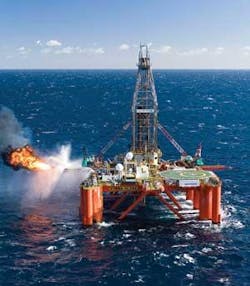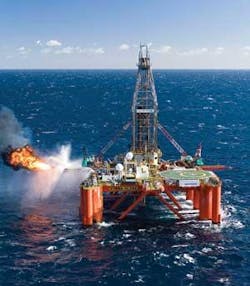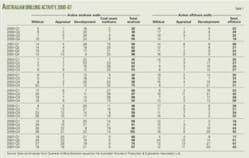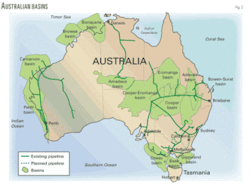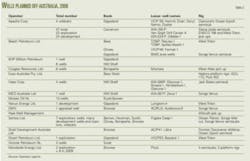Natural gas is driving drilling in Australia, while oil production continues to decline.
LNG trains have opened the market for Australia’s abundant natural gas. Operators are drilling for associated gas as well as coal seam gas (CSG).
In early September, energy economics group EnergyQuest said that Australian CSG production rose to 132.9 petajoules (22.8 mboe) for the year ending June 2008, up 38.9% from the previous year. Domestic gas production increased 2.3%, even though conventional production was down 2.1%, compensated by growth in Queensland CSG.
Well activity
Table 1 provides quarterly counts of wells being drilled on and offshore Australia 2000-07, breaking out wildcat, appraisal, development, and coal seam methane (CSM) wells. The counts are based on quarterly drilling statistics published by the Australian Petroleum Production & Exploration Association Ltd.1
The number of active land wells ranges from a low of 26 in first-quarter 2000 to a high of 103 in fourth-quarter 2006. The number of land wells rises from first to fourth-quarter about half the time.
There is no discernible trend for offshore wells. Offshore drilling activity was about 25% higher in 2003-04 and also jumped about 50% from 2006 to 2007.
Offshore framework
As of July 1, 2008, the Offshore Petroleum Act 2006 (OPA) became effective, replacing the Petroleum (Submerged Lands) Act of 1967. PSLA was rewritten to simplify, after years of amendments.
When he announced that the Governor-General proclaimed OPA and related Acts to come into effect, the Minister for Resources, Energy, and Tourism, the Hon. Martin Ferguson said this will make the offshore petroleum legislation easier to understand and reduce compliance and administrative costs to both industry and governments.2
In September, 17 mobile offshore drilling units were working off Australia for 9 different operators. These units included 1 drillship, 10 semisubmersibles, 4 jack ups, and 2 platform rigs. Two additional platform rigs were ready-stacked.
Woodside Petroleum was the most active operator, with four semisubs under contract. Apache Corp. had two semisubs and two jack ups working (Fig. 1); Santos had two semisubs; ExxonMobil through its subsidiary, Esso Australia Pty. Ltd., had two platform rigs; and several operators were each running a single rig: Coogee Resources Ltd., Eni SPA, Hess Corp., Peak Well Management, and Shell. Operators have wells planned in the Gippsland, Carnarvon, Bass, Otway, and Browse basins (Table 2).
Esso Australia also operates Australia’s largest privately owned helicopter fleet to service Bass Strait operations.
State agencies
The South Australia government will spend an additional $11 million (Aus.) over the next 4 years to strengthen its Primary Industries and Resources SA regulatory agency, so that E&P applications can be processed more efficiently.3 Operators apply to the Minerals and Energy Resources Division of PIRSA.
The Queensland government allocated $550,000 in its 2008-09 state budget for Queensland’s Petroleum and Gas Inspectorate. It is adding four staff to boost monitoring, inspections, and audits, because the state has more than 3,400 CSG locations.3
Queensland’s Minister for Mines and Energy, Geoff Wilson, said the Surat basin has abundant gas and is “set to rival the Bowen basin in central Queensland as the state’s economic powerhouse.”3
Consolidations
The industry is consolidating, evinced by a series of mergers of small Australian companies with coalbed methane (CBM) gas reserves that can be used for liquefied natural gas export projects.
Roc Oil Co. Ltd. recently won a 53.1% controlling share of Anzon Australia, a subsidiary of London-based Anzon Energy. Anzon has a 40% stake in Basker-Manta-Gummy oilfield (BMG) off Victoria.
Britain’s BG Group PLC attempted to take control of Perth-based Origin Energy Ltd. and its coal fields for $11 billion but was thwarted in early September. Origin initiated a CBM joint venture with ConocoPhillips, for which it received $8 billion. Conoco said it would book reserves of about 100 mboe from the JV in 2008.
South Perth-based Cooper Energy Ltd. bought 4.99% of Incremental Petroleum on the open market, then initiated an $86.4 million hostile takeover bid in September.
In April 2008, Beach Petroleum Ltd. sold a 10% interest in Basker-Manta-Gummy oil and gas fields to Sojitz Energy Australia Pty Ltd. for $123 million (Aus.). This reduced Beach’s equity in the field to 30%. Three wells in the field produce to the Crystal Ocean FPSO. A fourth well, the Basker-6, will be put online in September-October 2008. This well was drilled, sidetracked, cased, and completed as a three-zone tandem with smart completion technology to enable remote switching of production zones.4
Drilling consortia
Australian Drilling Associates (ADA) manages multioperator drilling consortia in Australia and New Zealand, coordinating jack ups and semisubmersibles. The company offers well engineering and drilling project management (www.australiandrilling.com.au).
Kan Tan IV semisub began a contract in mid-2007 for four operators and expanded to 12 wells over 540 days, in Bass Strait and New Zealand. The rig is owned by Sinopec, managed by Maersk Contractors (www.maersk-drilling.com), and will mobilize from the Caribbean during first-quarter 2009.
ADA provides project management for the wells and will coordinate and manage drilling operations once the rig leaves the Caribbean. The drilling program will serve: Origin Energy (four wells); Anzon Energy (three wells in Gippsland basin); Tap Oil (two exploration wells in Bass basin); Nexus (one of two wells in Gippsland).
Songa Offshore ASA’s Songa Venus semisub begins work October 2008 for an initial term of 376 days; potential second term of 376 days. The contract value for the primary term is about $150 million; the secondary term is a “mutually agreed market rate” (www.songaoffshore.no).
The consortium includes five operators scheduled to drill 10 wells in the North West Shelf area, Bass Strait, Timor Sea, and Browse basin. ADA provides well engineering and project management to each operator and will coordinate and manage all day-to-day operations once the rig is handed over from its current contract in Australia.
First well will be for MEO Australia Ltd. (one well, North West shelf); followed by CNOOC Ltd. (three wells in Timor Sea); Anzon Energy (three wells in Gippsland); Hawkestone Oil (two wells in Browse basin, 2009). The rig is also drilling for Albers Group.
Songa Venus has been drilling off Australia for ENI Australia and Inpex Browse (neither is part of the consortium).
West Triton (newbuild) jack up will work for ADA in a consortium arranged in 2007. The rig arrived in the Bass Strait off Victoria in February 2008 for a 324-day initial term. It’s a new rig for Norwegian contractor Seadrill and spud its first well, Wasabi-1, on Feb. 14 for Apache Energy.
This consortium consists of five operators who have a total of 11 wells scheduled in both the Gippsland and Otway basins: 3D Oil (2 wells drilled in Gippsland basin); Apache Energy (3 wells drilled in Gippsland, early 2008); Stuart Petroleum (1 well Gippsland basin); Beach Petroleum (3 wells in Otway and Bass basins); and Nexus (1 of 2 wells in Gippsland).
Contractors
Land drilling services in Australia are provided by a variety of small drilling contractors. The Australian Drilling Industry Association (ADIA) serves the oil and gas, water well, and geotechnical drilling industries and publishes a journal, Australasian Drilling.
Century Drilling Ltd., a division of Downer EDI Ltd., has a fleet of 13 rigs, working in Australia (4), Indonesia (4), New Zealand (2), India (2), and Oman (1). The Australia-based rigs are light-duty, 750-800 hp.
Oman-based MB Petroleum bought a 51% controlling stake in Century Drilling for $45 million in early September; the company will be renamed MB Century Drilling.
AED Oil
Australian Energy Developments Oil Ltd. and joint-venture partner East Puffin Pty. Ltd. plan to drill two wells in Puffin field. East Puffin spud the Puffin-11 exploration well in the southwest part of the field in water 86.6 m deep in the Timor Sea off Australia (Fig. 2) with Premium Drilling’s Wilcraft jack up rig. The company drilled a 171/2-in. hole to 975 m and set 133/8-in. casing with a shoe at 970.5 m. Drilling proceeded with 121/4-in. hole and reached 1,001 m by Sept. 11.
The second well, Puffin-12, will be drilled in the northeast area of the field.5
Apache
Apache Corp. has four wildcats planned for the Gippsland basin, using Diamond Offshore Drilling Inc.’s Ocean Epoch semisub (Table 2). The company also plans to drill 47 wells (23 exploration, 24 development) in the Carnarvon basin with the Stena Clyde semisub (Fig. 1), in permit WA-155-P.
The Apache-led Harriet joint venture is preparing to bring two wells on at the company’s producing Simpson oil field off Western Australia.
In early September, Apache spud the Dibbler-1 exploration well on permit WA-334-P in the Carnarvon basin off Western Australia, targeting gas in the Dupuy formation. The planned TD is 3,595 m and the well is only 215 m from the John Brookes gas pipelines belonging to the Harriet JV. Apache holds an 80% stake and partner Tap Oil has 20% in the permit.
Beach Petroleum Ltd.
During fiscal year 2008, Beach Petroleum participated in 108 wells in the Cooper Eromanga region, spanning exploration, appraisal, and development. Of the 108, 66 wells operated by Santos targeted oil, and 28 were exploration wells with a 32% success rate, resulting in the discovery of nine new oil fields.
Beach became involved in the Santos activities after acquiring Delhi Petroleum and its Cooper basin JV assets in late 2006.4
In the Gippsland basin, Beach and its JV partners have two semisubmersibles scheduled to drill three wells in the Bass and Otway basins (Table 2). This includes the PeeJay-1 well in tenement T/39P and the Spikey Beach-1 in tenement T/38P, both in the Bass basin. Beach said these two wells will test oil at the top of the Eastern View coal measures. The third well will be the Fermat-1 in VIC/P46 in the Otway basin.
The Songa Venus will begin a 120-150 day drilling program in December 2008. The Kan Tan IV will begin a 135-day program in May 2009.
BHP Billiton
BHP Billiton Petroleum is Australia’s largest oil and gas producer. The company increased its exploration spending in fiscal year 2008 to about $700 million from $395 million in previous year. Spending in fiscal year 2009 will be equal to or exceed current spending. Worldwide, the company will drill 24 exploration and appraisal wells in short-term; 7 of these in Australia.6
Bass Strait is one of the company’s four “base producing areas” worldwide. After nearly 40 years, BHP Billiton “achieved record winter gas sales.” BHP has 32.5% of Kipper project, 80 MMcfd natural gas and 10,000 bo/d condensate development (gross). The company has executed subsea contracts and anticipates startup in 2011. On July 25, BHP sanctioned Turrum gas field development in the Bass strait; BHP has 50% and will spend $625 million.6
In Western Australia, BHP has 41 permits, with working interests from 8.3-100% on 9.2 million acres (gross), in water depths 170-2,500 m. Recently BHP had two major discoveries in the Exmouth area: Thebe and Scarborough.
Stybarrow FPSO and subsea well project in 2,707 ft water depth began production in November 2007. BHP operates Stybarrow (50% working interest). The project has record-setting single well flow rates of 32,000 bo/d and sustained gross production of 80,000 bo/d.
Also in WA, BHP has 71.43% of the Pyrenees project in water 820 ft deep. The company expects 96,000 bo/d and 60 MMcfd gas. With the FPSO conversion underway, startup should be first-half 2010.
In the future in Western Australia, the Macedon project in Exmouth area will require subsea wells and a gas plant. BHP has 71.43%. There are also three LNG projects planned: Thebe, Scarborough, and Browse.
In the North West Shelf JV, the fifth LNG train (T5) is due by late 2008 and BHP has 16.67%.
Angel is a 800 MMcfd and 50,000 bo/d condensate development. Topsides are installed; expect start-up by yearend 2008 (BHP, 16.67%).
North Rankin B project is a 2.5-bcfd gas facility, sanctioned in March 2008. BHP has 16.67% and start-up is expected in 2012.
Central Petroleum
South Perth-based onshore explorer Central Petroleum Ltd. has a seven-well 2008 drilling program. The company is analyzing results of its first well in the frontier Pedirka basin of Central Australia, contiguous with the Cooper basin.
Log results suggest that the Blamore-1 hit a Permian coal sequence that was four times thicker than expected.
The Permian sequence of coals seen at Blamore-1 will be further tested in CBM well 93001, the next well to be drilled.
Chevron
Chevron Australia Pty. Ltd. has been in Australia for more than 50 years. The company operates Gorgon and Wheatstone projects, Barrow Island and Thevenard oil fields, and is a founding partner of the North West Shelf Venture.
The company is now offering engineering contracts for the Barrow Island and Thevenard Island projects.
In early September, Chevron announced a $400 million commitment to an exploration program off Western Australia aimed at finding more natural gas for its planned LNG plants.
ConocoPhillips
Several companies are pursuing new gas developments in the Timor Sea to feed into Darwin LNG. The Timor-Bonaparte basin drilling programs include:
- ConocoPhillips’s Barossa and Caldita fields in Timor basin.
- Caldita field, 265 km northwest of Darwin is being appraised. The Caldita-2 well was drilled to 3,973 m in 2007; there are new 3D seismic surveys over Caldita and Barossa structures.
The Bayu-Undan field was discovered 1995, 500 km northwest of Darwin, in Timor Sea. It has expected reserves of 3.4 tcf gas and 400 million bbl of condensate and LPG.
The development will require a wellhead platform, a central production and processing complex, an FSO, and a 500-km pipeline to ConocoPhillips’s Darwin LNG plant at Wickham Point in Darwin Harbor. The project life is 25 years and will require 22 wells; 12 are already drilled.
Coogee Resources
West Perth-based Coogee Resources Ltd. has assets in the Timor Sea and Bonaparte basin. It began a 4-year, 11-well drilling program in late 2007.
The company has postponed drilling its exploratory Wisteria well off northwest Australia until next year. It needed the West Atlas jack up for installation work at its Montara project, which includes Montara, Skua, and Swift-Swallow oil fields. The development plan for Montara includes nine wells, six already drilled in Phase 1, and three in Phase 2, to be completed in third-quarter 2009.7
Cooper Energy
On Sept. 10, Cooper announced that it would recommence its drilling program in the Cooper basin in early December, after securing the Ensign No. 30 rig. The company will drill two low-risk exploration wells in PEL92, targeting the Gunyah and Perlubie prospects. These are slightly south of the Parsons-2 well in recently discovered Parsons oil field.
TD for the Gunyah-1 is 2,050 m and the well will cost $1.8 million (Aus.). TD for the Perlubie-1 is 1,796 m and it will cost $1.6 million (Aus.).
Empire Oil & Gas
Perth-based Empire Oil & Gas NL shifted the drilling site for the long-delayed Lake MacLeod-1 well in the onshore Carnarvon basin, Western Australia. The well, in the Gascoyne subbasin, was about to spud in mid-September. DCA Rig 7 was rigging up Sept. 16. The well targets the Lake MacLeod anticlinal structure on the EP 439 and EP 461 permits and will be drilled to 1,000 m.8
Partners include Rough Range Oil Pty. Ltd. (operator, 30.35%); Jurassica Oil & Gas (35%); Longreach Oil (9.352%); Indigo Oil (4.676%); Falcore (2.596%); and Vigilant Oil (0.52%). Black Fire Energy and DVM International earned stakes of 7.5% and 10% under farm-in deals.
Empire reported that the Western Australian Dept. of Industry and Resources approved the plan for the Bee-eater-1 well on Aug. 15. That well will be drilled on EP 359 in the Exmouth subbasin of the Canning basin, immediately following the MacLeod-1 well.
Rough Range operates the Bee-eater-1 well (33.36%) on behalf of Victoria Petroleum (31.65%), Pace Petroleum (1.67%); and farm-in partners (33.32%).
Magellan Petroleum Corp.
Magellan has three core areas in Australia:9
- Amadeus basin, central Australia.
- Cooper-Eromanga basins, central Australia.
- Coal seam gas in Maryborough basin, eastern Australia.
The Amadeus basin includes three fields. Magellan operates Palm Valley field (52%; Santos 48%). Santos operates Mereenie field, 62 wells drilled (65%, Magellan 35%); and Dingo field (65.7%; Magellan 34.3%)
The Cooper-Eromanga basins are Australia’s most prolific onshore hydrocarbon province. Magellan has interests in seven production leases and six exploration licenses. But production is operated by Santos and Beach Petroleum.
In CSG, Magellan has interests in 3 permits, ATP-613P, ATPA-674P, and ATPA-733P. There have been five wells drilled in the Cretaceous Burrum coal measures, which are younger than the Permian coals in the Bowen basin and the Jurassic coals in the Surat basin.9
Mosaic Oil
Mosaic Oil NL has increased its 2008 drilling program to 12 wells, up from 10, all in the Surat-Bowen basin.
The company has several drill sites in Queensland. It spud the Freneau-1 exploration well on the ATP 709P permit with the Century 7 rig in early September and said it would take about 16 days to drill to the potential gas and condensate reservoir at 2,400 m.10
New Standard Energy
West Perth-based New Standard Energy Ltd., formerly Hawk Resources Ltd., has large land holdings in the south Canning basin. It spud its Lanagan-1 well on the EP 417 permit in the Canning basin in Western Australia in August, with ADS Rig 6.
According to a company drilling report, the well reached 1,490 m on Sept. 17 with no show of hydrocarbons in the Laurel sandstone.
The well would be drilled to 1,530 TD, logged, and probably plugged and abandoned.
New Standard said it plans to drill a second well on EP 417 by the end of the year.11
Nexus Energy Ltd.
Nexus Energy will spend $1 billion in exploration over next 3 years to find enough gas for an LNG project. The company plans to focus on offshore Crux field, in exploration permit AC/P23, Browse basin.
Nexus Energy recently drilled the Longtom-4 development well on permit VIC/L29 in the Gippsland basin off southeast Australia with the West Triton jack up. Nexus announced that it intersected 100 m of gas sands and would run a production test in mid-September.12
Santos
Santos Ltd. has drilled a lot of development and injection wells and coreholes this year and also planned a seven-well exploration drilling program off Australia. The exploration program includes two wells in the Otway basin and a single well in the Barrow, Houtman, Sorell, Bonaparte, and Browse basins.13
The company has two semisubmersibles under contract—Ocean Patriot and Songa Mercur.
In late August, Santos announced that it hit gas in its Frigate Deep-1 wildcat well near the company’s Petrel-Tern fields in the Bonaparte basin off northern Australia.13
Stuart Petroleum
In late August, Adelaide-based Stuart Petroleum Ltd. announced that it bought a 50% operating stake in Oliver oilfield in the Timor Sea off northwest Australia.
In September, the company began drilling the Bazzard 1 exploration well in permit VIC P53 in the Gippsland basin. Stuart is a member of the Bass Strait drilling consortium enabling it to secure a slot on the West Triton jack up drilling rig
Stuart estimated the drilling costs at $20 million (Aus.). Stuart is assuming the total cost to earn a 50% equity share and operatorship in the permit, along with partners Cue Petroleum Pty Ltd. (25%), Exoil Ltd. (16.667%), and Moby Oil & Gas Ltd. (8.333%).14
Victoria Petroleum
Perth-based Victoria Petroleum NL planned to drill 20 wells in June-December 2008.15
This includes 3 wells on two permits in the Surat basin, 17 wells in the Cooper basin on three permits, and single wells in the Perth and Carnarvon basins.
In August, Victoria Petroleum NL spud the Growler-4 appraisal well on the PRL 15 permit in South Australia’s Cooper basin. The new well is being drilled to 1,800 m TD to test the extent of oil pay found in the Jurassic Birkhead formation in the Growler-1 well and test secondary targets in the Namur and Hutton sandstones.
Victoria said the well was 400 m north of Growler-1 and would test the crest of the structure. The company spud a second appraisal well, Growler-3, immediately afterward, in late August.
Both wells showed positive oil; Growler-3 flowed 1,673 bo/d according to company reports in September, and was completed as a production well. The rig moved to spud the Warhawk-1 well in mid-September.
Woodside
In September, Woodside Energy Ltd. said it would drill as many as eight exploration wells off Western Australia next year. The company is seeking additional natural gas for a proposed expansion of its 90%-owned Pluto LNG project. JV partners Tokyo Gas and Kansai Electric each have 5%.
Plans for a second train at Pluto are in danger after Woodside’s Bellatrix-1 well came up dry. It was the third dry hole in the Pluto exploration area, following the Ixion-1, drilled earlier this year, and Belicoso-1, drilled late last year.
Woodside has two more exploration well to drill in the greater Pluto area before the end of 2008.
References
- APPEA; www.appea.com.au.
- “New offshore petroleum legislation from 1 July,” June 27, 2008, http://minister.ret.gov.au/TheHonMartinFergusonMP/Pages.
- Gas Today Australia magazine, August 2008, p. 10, www.gas-today.com.au.
- Beach Petroleum Ltd., 2008 preliminary final report, June 30, 2008 and Director’s Letter, Aug. 29, 2008.
- Drilling Progress Report No.1, Sept. 11, 2008, www.aedoil.com.
- BHP Billiton, www.bhpbilliton.com.
- Coogee Resources Ltd., www.coogeeresources.com.au.
- Empire Oil & Gas NL, www.empireoil.com.au.
- Magellan Petroleum Corp., www.magpet.com.au/profile.html.
- Mosaic Oil NL, www.mosaicoil.com.
- New Standard Energy Ltd., http://newstandard.com.au.
- Nexus Energy Ltd., www.nexusenergy.com.au.
- Santos Ltd., www.santos.com.
- Stuart Petroleum Ltd., www.stuartpetroleum.com.au.
- Victoria Petroleum NL, 2008 Drilling Schedule, http://www.vicpet.com.au/Schedule/.
